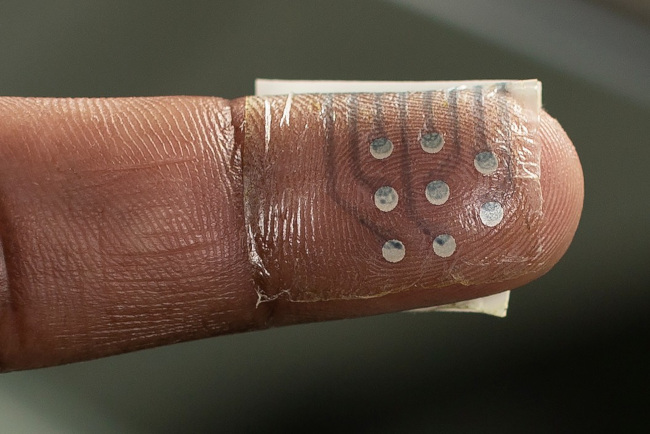Communications of the ACM
How Electronic Skin Could Help People With Disabilities

Anusha Withana with a piece of electronic skin.
Credit: University of Sydney
Virtual buttons, also called soft keys, are used on smartphones, ATMs, and computer monitors to do the work of buttons though they are just an image.
Virtual buttons are handy and efficient, unless you're vision impaired, because a user can't actually feel them.
Anusha Withana is looking for solutions in what is one of the fastest growing areas of scientific research: electronic skin, "My research is about creating blended interfaces," says Withana, a lecturer in human computer interaction in the School of Computer Science at the University of Sydney. "Meaning technology that can be worn without being noticed."
Wearable Technology
Working with colleagues, Withana is developing a super-thin, hyper-flexible sticky tape that can have electronic circuits printed onto it. Once applied to the skin, a person could use it to control devices, receive information, and importantly, register sensations through mobile phone-like vibrations. This could have benefits in robotics, education, and game-playing and for people with disabilities.
An added advantage of tactile information is that it doesn't distract people in the same way that visual or auditory information might. As Withana points out, "some vision-impaired people prefer not to have information come to them through sound, because that's their connection with the world. If information can come to them in a tactile way, that's better."
High-Tech Tattoo
To that end, Withana is working with a team in Germany to develop what is effectively a printable electronic fake tattoo called the Tacttoo, that can be personalized to meet specific needs. A fake tattoo it might be, but there are no gaudy dragons or unicorns here. Instead, the Tacttoo is screen-printed with a circuit made from polymer-based conductive inks which can stretch and move with the skin, while all connections between the skin and the electronics are printed in skin-safe silver ink.

The 'feel through interface,' as in the sticky tape element, is only half the thickness of a human hair, making it the thinnest wearable tactile device to date, and so thin that it doesn't interfere with the normal sense of touch. Tacttoos are also inexpensive: mass produced, the material content would cost less than 1 cent each.
"We want people to be able to wear it today and remove it tomorrow—and we want people to be able to create it themselves," Withana says. "A broader user goal is to allow people with vision impairment to explore graphical information and more fully comprehend objects in museums and parks. This is something we're looking at with a team from Monash University."
Withana grew up in Sri Lanka, and received his Ph.D. at Keio University, in Japan. There he saw how technology could help people improve their quality of life. He also saw that only a fraction of tech advances are accessible to all people. "Everybody is unique, and if you are challenged in some way, those challenges are also unique. So I began looking at how technology can be personalized," Withana says.
A move to Germany and the Saarland University saw him join its world-leading Max Planck Institute for Informatics. Working with Daniel Groeger and Juergen Steimle he explored new ways of evolving the technology. Now Withana is pursuing ideas at the University of Sydney that could be used in any number of ways.
In a not-too-distant future, someone with a robotic hand will be able to sense heat from a cup, or gauge how much pressure to apply to an object. A stroke patient might have a personalized interface with sensors that measure their progress and give them feedback. A surgeon doing surgery remotely could get the same sense of pressure or dexterity that they would have if they were there in person.
As well, these wearable technologies will be connected to smart watches to control music or take calls. In 20 years, an entire smart device—including energy harvesting batteries — may be printable and worn on the skin.
The capabilities of these devices were once science fiction. Now they're science in action.
No entries found